Tourism's Impact on Grampians National Park: An Annotated Bibliography
VerifiedAdded on 2022/08/31
|9
|2244
|41
Annotated Bibliography
AI Summary
This annotated bibliography explores the multifaceted impacts of tourism on Grampians National Park, Australia, drawing from five articles published between 2015 and 2019. The bibliography includes three academic journal articles and two non-academic articles, focusing on various aspects of tourism, including indigenous rock art tourism, nature-based tourism trends, rock climbing impacts, tourism expenditure growth, and domestic demand for indigenous tourism. The articles delve into the development of the park, tourism policies, and the effects of tourism on the local environment and community. Key themes include the challenges and opportunities of indigenous tourism, the balance between conservation and visitation, and the economic benefits of tourism. The bibliography highlights the importance of sustainable tourism practices and the need for a nuanced understanding of tourism's effects on the Grampians region.
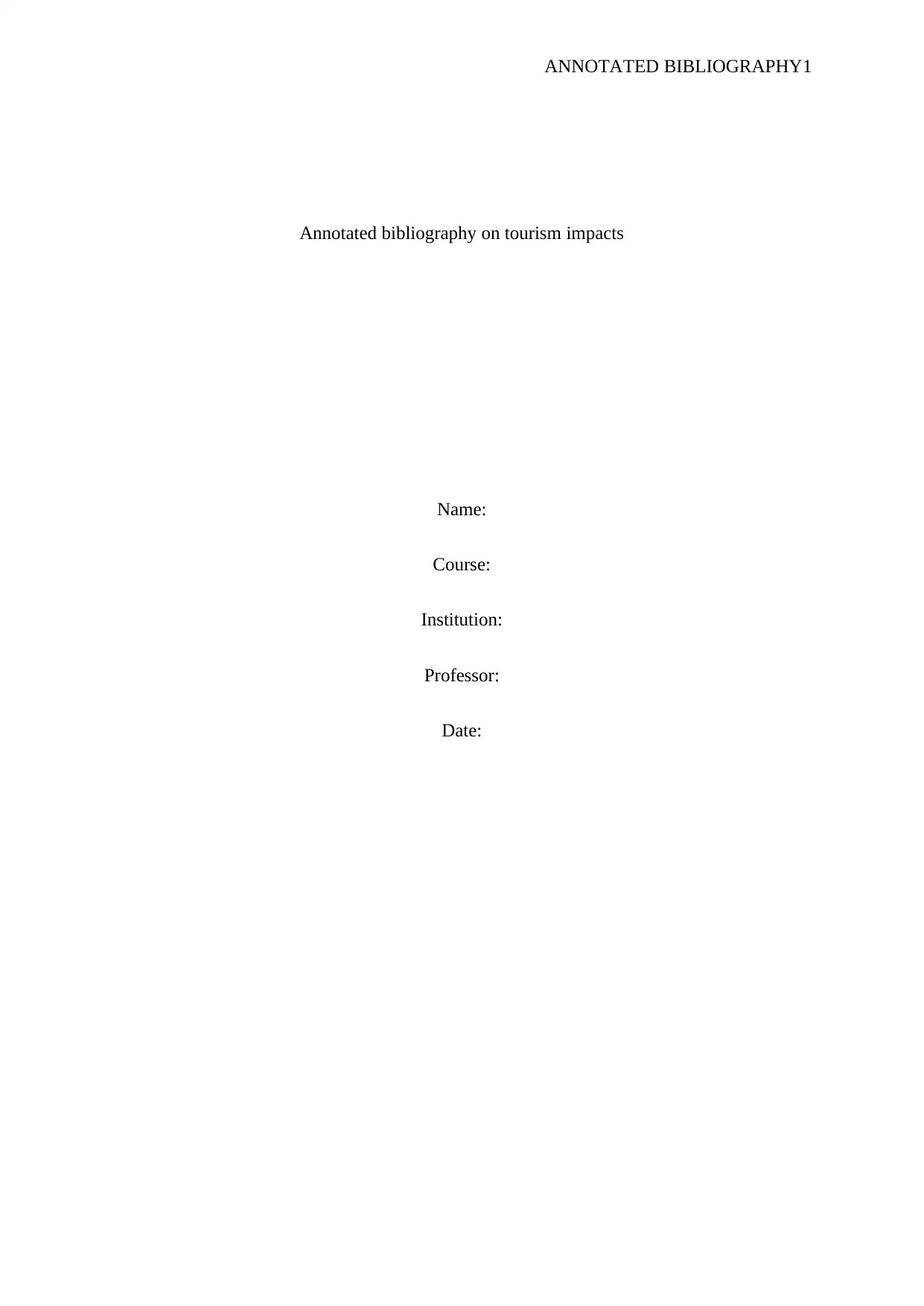
ANNOTATED BIBLIOGRAPHY1
Annotated bibliography on tourism impacts
Name:
Course:
Institution:
Professor:
Date:
Annotated bibliography on tourism impacts
Name:
Course:
Institution:
Professor:
Date:
Paraphrase This Document
Need a fresh take? Get an instant paraphrase of this document with our AI Paraphraser

ANNOTATED BIBLIOGRAPHY2
Introduction
The scope of this excerpt is to prepare an annotated bibliography comprising of five
articles, three of which are academic journal articles, while the other two are non-academic
articles. These articles ought to have been published in the period between 2019 and 2015.
The annotated bibliography covers the tourism impacts concerning Grampians National Park.
The discussion extends to include the development of Grampians National park and also the
tourism policy. t
Cole, NA and Wallis, LA 2019,” Indigenous Rock Art Tourism in Australia: Contexts,
Trajectories and Multifaceted Realities.” Journal of arts, 8(4), 162
The article gives attention to a field which has received limited research
attention. This field is referred to as Australian indigenous art tourism. The scope of
this article covers the aspect of destination development. The writes aim at identifying
the invisible elements in tourism promotions. The study uses the case of Quinkan
(Laura Cooktown region) and Kakadu national park to outline the development of
indigenous rock art tourism. The contribution has informed the choice of the two
regions of inheritance of leadership aspect. The aboriginal people of these two regions
inherited legacies of top-down bureaucratic methods and decision making. The Laura
community are still challenged by achieving the aspirations for sustainable rock art
tourism. This is even though they transitioned a successful ranger program and a
community-based system. The joint management arrangement with world heritage
listed national parks and adopted by KNP communities led to competition in
perspectives and values of the dominating state system. The KNP introduced the
Balnggarrawarra tourism initiative briefly and was operated by Laura. Critical
components of sustainable indigenous tourism are incorporated into the model. The
Introduction
The scope of this excerpt is to prepare an annotated bibliography comprising of five
articles, three of which are academic journal articles, while the other two are non-academic
articles. These articles ought to have been published in the period between 2019 and 2015.
The annotated bibliography covers the tourism impacts concerning Grampians National Park.
The discussion extends to include the development of Grampians National park and also the
tourism policy. t
Cole, NA and Wallis, LA 2019,” Indigenous Rock Art Tourism in Australia: Contexts,
Trajectories and Multifaceted Realities.” Journal of arts, 8(4), 162
The article gives attention to a field which has received limited research
attention. This field is referred to as Australian indigenous art tourism. The scope of
this article covers the aspect of destination development. The writes aim at identifying
the invisible elements in tourism promotions. The study uses the case of Quinkan
(Laura Cooktown region) and Kakadu national park to outline the development of
indigenous rock art tourism. The contribution has informed the choice of the two
regions of inheritance of leadership aspect. The aboriginal people of these two regions
inherited legacies of top-down bureaucratic methods and decision making. The Laura
community are still challenged by achieving the aspirations for sustainable rock art
tourism. This is even though they transitioned a successful ranger program and a
community-based system. The joint management arrangement with world heritage
listed national parks and adopted by KNP communities led to competition in
perspectives and values of the dominating state system. The KNP introduced the
Balnggarrawarra tourism initiative briefly and was operated by Laura. Critical
components of sustainable indigenous tourism are incorporated into the model. The

ANNOTATED BIBLIOGRAPHY3
elements include public education, partnerships, cultural preservation, conservation,
land care, jobs and traditional owner control. The caring for rock art serves as a
unifying theme despite the existence of contemporary realities and challenges.
The authors of the article note that on the global scale, the visitation to
Australian rock art destination is less. However, the operating modes and contexts are
diverse, just like the challenges on a worldwide scale. Rock art tourism as a national
industry suffers from limited information and thus limits its policymaking process.
The industry requires realistic market analysis and reliable data to provide useful
support to potential and existing indigenous rock art tourism stakeholders and
providers. The actual potential for art-rock tourism is better reflected by reliable data
provide by systematic cultural heritage survey. The article articulates that due to
challenges of developing remote and small business, there is limited participation and
hence there are few indigenous business firms that opt to conduct specialised rock art
tours.
Hardiman, N and Burgin, S 2017, “Nature tourism trends in Australia with reference to
the Greater blue mountains world heritage area.” Journal of sustainable tourism, 25(6),
732-745
The authors of this article take the challenging role of evaluating and
examining the nature-based tourism, which has been overlooked but with time
emerged a large and growing section of the tourism market. The article continues to
review the arguments by the advocates of nature-based tourism, who asserts that the
segment has the potential to generate revenue for local economic benefit and
biodiversity conservation. On a similar approach, the article authors review the
argument of the critics who assert that there is a risk of “loving our park to death.”
elements include public education, partnerships, cultural preservation, conservation,
land care, jobs and traditional owner control. The caring for rock art serves as a
unifying theme despite the existence of contemporary realities and challenges.
The authors of the article note that on the global scale, the visitation to
Australian rock art destination is less. However, the operating modes and contexts are
diverse, just like the challenges on a worldwide scale. Rock art tourism as a national
industry suffers from limited information and thus limits its policymaking process.
The industry requires realistic market analysis and reliable data to provide useful
support to potential and existing indigenous rock art tourism stakeholders and
providers. The actual potential for art-rock tourism is better reflected by reliable data
provide by systematic cultural heritage survey. The article articulates that due to
challenges of developing remote and small business, there is limited participation and
hence there are few indigenous business firms that opt to conduct specialised rock art
tours.
Hardiman, N and Burgin, S 2017, “Nature tourism trends in Australia with reference to
the Greater blue mountains world heritage area.” Journal of sustainable tourism, 25(6),
732-745
The authors of this article take the challenging role of evaluating and
examining the nature-based tourism, which has been overlooked but with time
emerged a large and growing section of the tourism market. The article continues to
review the arguments by the advocates of nature-based tourism, who asserts that the
segment has the potential to generate revenue for local economic benefit and
biodiversity conservation. On a similar approach, the article authors review the
argument of the critics who assert that there is a risk of “loving our park to death.”
⊘ This is a preview!⊘
Do you want full access?
Subscribe today to unlock all pages.

Trusted by 1+ million students worldwide
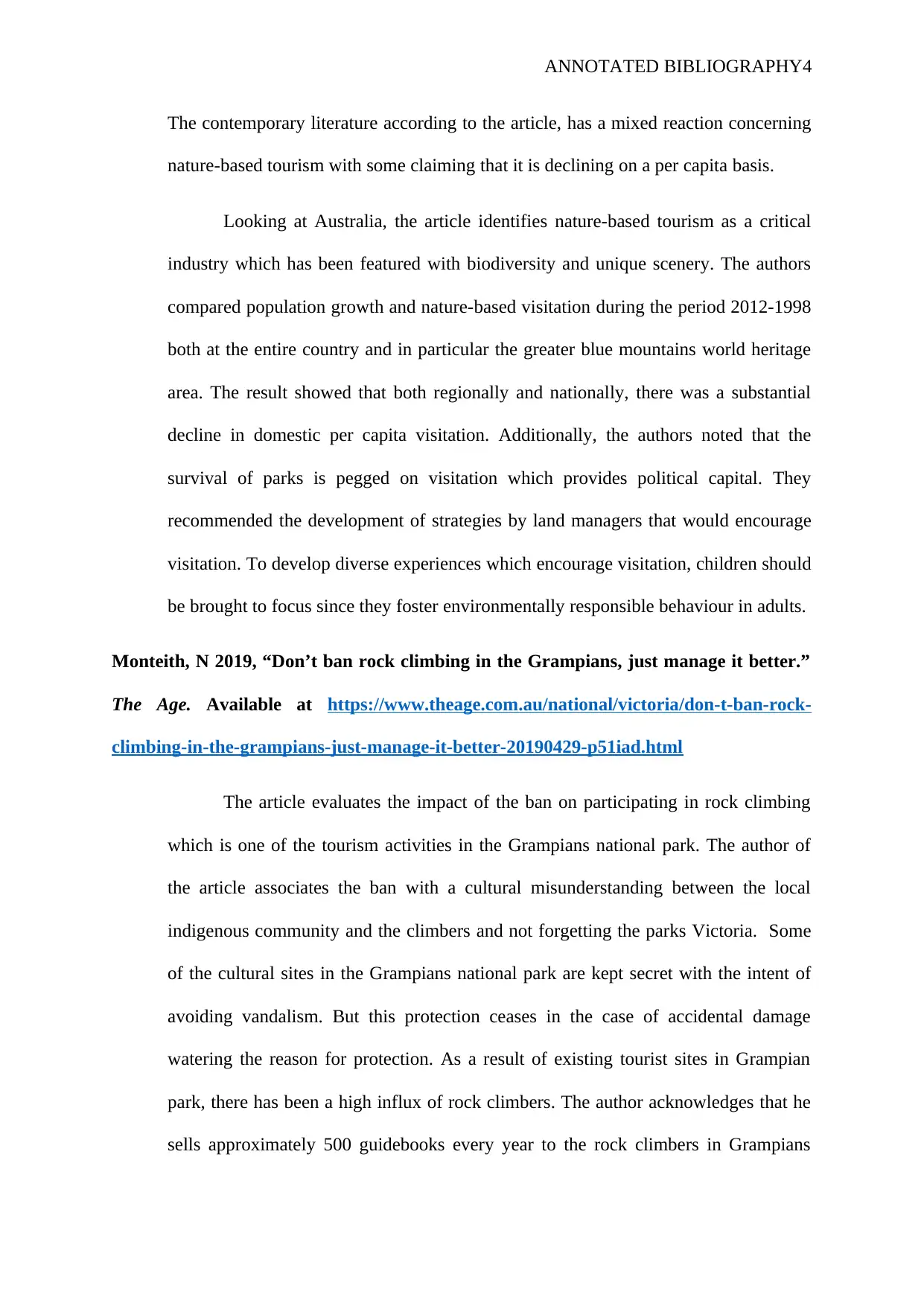
ANNOTATED BIBLIOGRAPHY4
The contemporary literature according to the article, has a mixed reaction concerning
nature-based tourism with some claiming that it is declining on a per capita basis.
Looking at Australia, the article identifies nature-based tourism as a critical
industry which has been featured with biodiversity and unique scenery. The authors
compared population growth and nature-based visitation during the period 2012-1998
both at the entire country and in particular the greater blue mountains world heritage
area. The result showed that both regionally and nationally, there was a substantial
decline in domestic per capita visitation. Additionally, the authors noted that the
survival of parks is pegged on visitation which provides political capital. They
recommended the development of strategies by land managers that would encourage
visitation. To develop diverse experiences which encourage visitation, children should
be brought to focus since they foster environmentally responsible behaviour in adults.
Monteith, N 2019, “Don’t ban rock climbing in the Grampians, just manage it better.”
The Age. Available at https://www.theage.com.au/national/victoria/don-t-ban-rock-
climbing-in-the-grampians-just-manage-it-better-20190429-p51iad.html
The article evaluates the impact of the ban on participating in rock climbing
which is one of the tourism activities in the Grampians national park. The author of
the article associates the ban with a cultural misunderstanding between the local
indigenous community and the climbers and not forgetting the parks Victoria. Some
of the cultural sites in the Grampians national park are kept secret with the intent of
avoiding vandalism. But this protection ceases in the case of accidental damage
watering the reason for protection. As a result of existing tourist sites in Grampian
park, there has been a high influx of rock climbers. The author acknowledges that he
sells approximately 500 guidebooks every year to the rock climbers in Grampians
The contemporary literature according to the article, has a mixed reaction concerning
nature-based tourism with some claiming that it is declining on a per capita basis.
Looking at Australia, the article identifies nature-based tourism as a critical
industry which has been featured with biodiversity and unique scenery. The authors
compared population growth and nature-based visitation during the period 2012-1998
both at the entire country and in particular the greater blue mountains world heritage
area. The result showed that both regionally and nationally, there was a substantial
decline in domestic per capita visitation. Additionally, the authors noted that the
survival of parks is pegged on visitation which provides political capital. They
recommended the development of strategies by land managers that would encourage
visitation. To develop diverse experiences which encourage visitation, children should
be brought to focus since they foster environmentally responsible behaviour in adults.
Monteith, N 2019, “Don’t ban rock climbing in the Grampians, just manage it better.”
The Age. Available at https://www.theage.com.au/national/victoria/don-t-ban-rock-
climbing-in-the-grampians-just-manage-it-better-20190429-p51iad.html
The article evaluates the impact of the ban on participating in rock climbing
which is one of the tourism activities in the Grampians national park. The author of
the article associates the ban with a cultural misunderstanding between the local
indigenous community and the climbers and not forgetting the parks Victoria. Some
of the cultural sites in the Grampians national park are kept secret with the intent of
avoiding vandalism. But this protection ceases in the case of accidental damage
watering the reason for protection. As a result of existing tourist sites in Grampian
park, there has been a high influx of rock climbers. The author acknowledges that he
sells approximately 500 guidebooks every year to the rock climbers in Grampians
Paraphrase This Document
Need a fresh take? Get an instant paraphrase of this document with our AI Paraphraser

ANNOTATED BIBLIOGRAPHY5
national park. As a result of the push by the Australian national government towards
national tourism, the author notes that the Grampians receives over one million
tourists every year. The massive tourism has resulted in environmental pollution
where every car park or lookout has turned into a minefield of rubbish and human
waste.
The author asserts that the impact of rock climbers in the park is negligible in
comparison to what society considers acceptable while pursuing the broad aspect of
growth and development. The booming tourism has necessitated parks Victoria to
plough new walking trails and huts. This has opened up tourism in the park as more
visitors can walk through the park at a minimum of $50. By the end of the year 2019,
it was estimated that the Grampians peak trail would have had an estimated visitation
of 23,000 people. Other than banning rock climbing, the writer opines that the
Grampians should consider hiring a dedicated climber-focused ranger, install signs,
revegetate erosion and build proper trails. The contribution of the rock climbers to the
park cannot be ignored. The writer is of the view that the imposition of the ban was
unfair and unjustified.
Rennison, A 2018, “Tourism growth and expenditure in the Grampians.” Mail Times.
Available at https://www.mailtimes.com.au/story/5536236/grampians-tourism-
continues-to-grow/
The article examines the growth rate of tourism in the Grampians national
park leading to increase revenue collection. The author notes the continuous rise of
visitation in the Grampians. In 2007, the writer accounted for an increase in
Grampians’ visitors by 15.7%. Between March 2018 and March 2017, it was recorded
that approximately 931,000 visitors travelled to the Grampians. This has led to an
national park. As a result of the push by the Australian national government towards
national tourism, the author notes that the Grampians receives over one million
tourists every year. The massive tourism has resulted in environmental pollution
where every car park or lookout has turned into a minefield of rubbish and human
waste.
The author asserts that the impact of rock climbers in the park is negligible in
comparison to what society considers acceptable while pursuing the broad aspect of
growth and development. The booming tourism has necessitated parks Victoria to
plough new walking trails and huts. This has opened up tourism in the park as more
visitors can walk through the park at a minimum of $50. By the end of the year 2019,
it was estimated that the Grampians peak trail would have had an estimated visitation
of 23,000 people. Other than banning rock climbing, the writer opines that the
Grampians should consider hiring a dedicated climber-focused ranger, install signs,
revegetate erosion and build proper trails. The contribution of the rock climbers to the
park cannot be ignored. The writer is of the view that the imposition of the ban was
unfair and unjustified.
Rennison, A 2018, “Tourism growth and expenditure in the Grampians.” Mail Times.
Available at https://www.mailtimes.com.au/story/5536236/grampians-tourism-
continues-to-grow/
The article examines the growth rate of tourism in the Grampians national
park leading to increase revenue collection. The author notes the continuous rise of
visitation in the Grampians. In 2007, the writer accounted for an increase in
Grampians’ visitors by 15.7%. Between March 2018 and March 2017, it was recorded
that approximately 931,000 visitors travelled to the Grampians. This has led to an
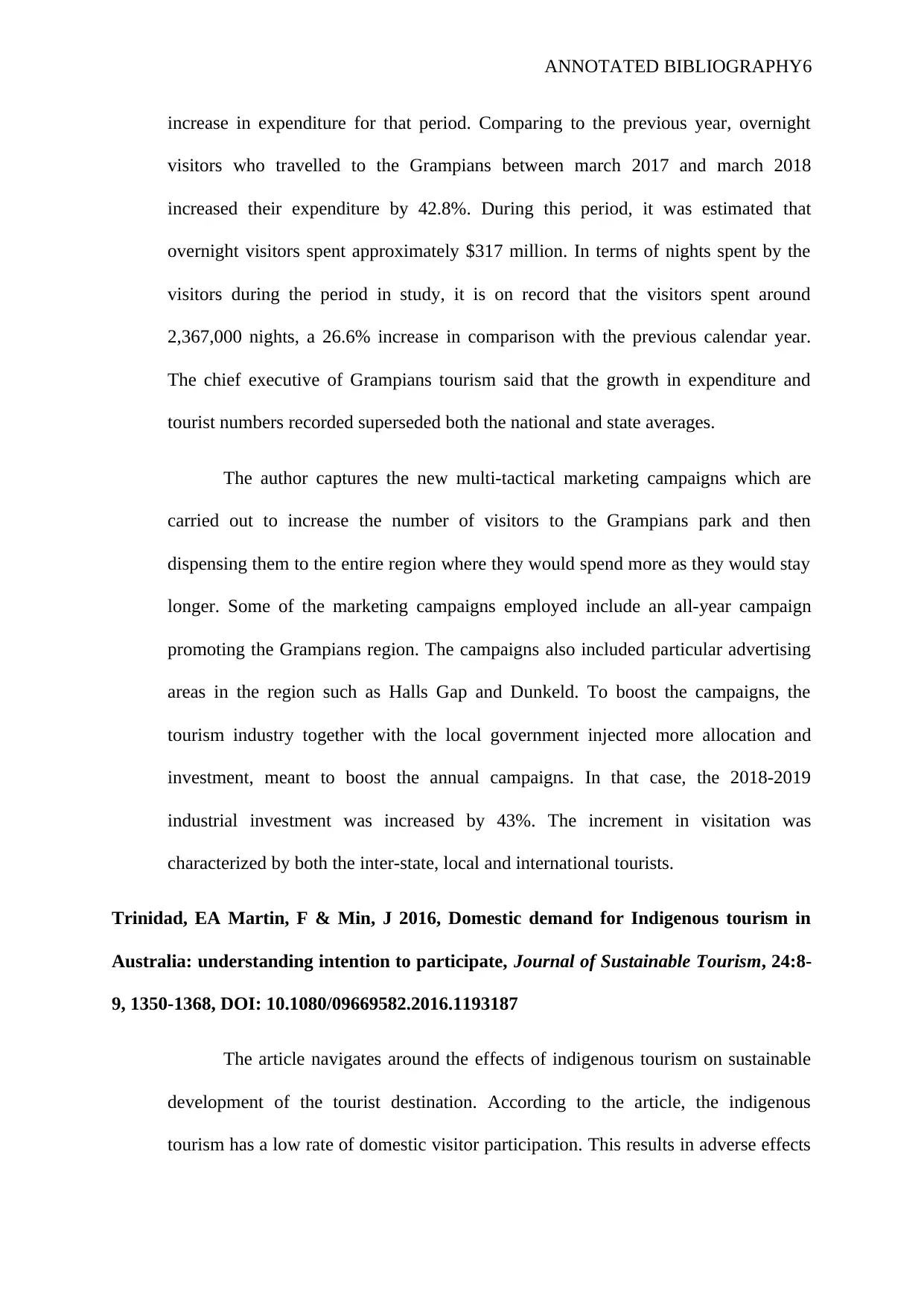
ANNOTATED BIBLIOGRAPHY6
increase in expenditure for that period. Comparing to the previous year, overnight
visitors who travelled to the Grampians between march 2017 and march 2018
increased their expenditure by 42.8%. During this period, it was estimated that
overnight visitors spent approximately $317 million. In terms of nights spent by the
visitors during the period in study, it is on record that the visitors spent around
2,367,000 nights, a 26.6% increase in comparison with the previous calendar year.
The chief executive of Grampians tourism said that the growth in expenditure and
tourist numbers recorded superseded both the national and state averages.
The author captures the new multi-tactical marketing campaigns which are
carried out to increase the number of visitors to the Grampians park and then
dispensing them to the entire region where they would spend more as they would stay
longer. Some of the marketing campaigns employed include an all-year campaign
promoting the Grampians region. The campaigns also included particular advertising
areas in the region such as Halls Gap and Dunkeld. To boost the campaigns, the
tourism industry together with the local government injected more allocation and
investment, meant to boost the annual campaigns. In that case, the 2018-2019
industrial investment was increased by 43%. The increment in visitation was
characterized by both the inter-state, local and international tourists.
Trinidad, EA Martin, F & Min, J 2016, Domestic demand for Indigenous tourism in
Australia: understanding intention to participate, Journal of Sustainable Tourism, 24:8-
9, 1350-1368, DOI: 10.1080/09669582.2016.1193187
The article navigates around the effects of indigenous tourism on sustainable
development of the tourist destination. According to the article, the indigenous
tourism has a low rate of domestic visitor participation. This results in adverse effects
increase in expenditure for that period. Comparing to the previous year, overnight
visitors who travelled to the Grampians between march 2017 and march 2018
increased their expenditure by 42.8%. During this period, it was estimated that
overnight visitors spent approximately $317 million. In terms of nights spent by the
visitors during the period in study, it is on record that the visitors spent around
2,367,000 nights, a 26.6% increase in comparison with the previous calendar year.
The chief executive of Grampians tourism said that the growth in expenditure and
tourist numbers recorded superseded both the national and state averages.
The author captures the new multi-tactical marketing campaigns which are
carried out to increase the number of visitors to the Grampians park and then
dispensing them to the entire region where they would spend more as they would stay
longer. Some of the marketing campaigns employed include an all-year campaign
promoting the Grampians region. The campaigns also included particular advertising
areas in the region such as Halls Gap and Dunkeld. To boost the campaigns, the
tourism industry together with the local government injected more allocation and
investment, meant to boost the annual campaigns. In that case, the 2018-2019
industrial investment was increased by 43%. The increment in visitation was
characterized by both the inter-state, local and international tourists.
Trinidad, EA Martin, F & Min, J 2016, Domestic demand for Indigenous tourism in
Australia: understanding intention to participate, Journal of Sustainable Tourism, 24:8-
9, 1350-1368, DOI: 10.1080/09669582.2016.1193187
The article navigates around the effects of indigenous tourism on sustainable
development of the tourist destination. According to the article, the indigenous
tourism has a low rate of domestic visitor participation. This results in adverse effects
⊘ This is a preview!⊘
Do you want full access?
Subscribe today to unlock all pages.

Trusted by 1+ million students worldwide
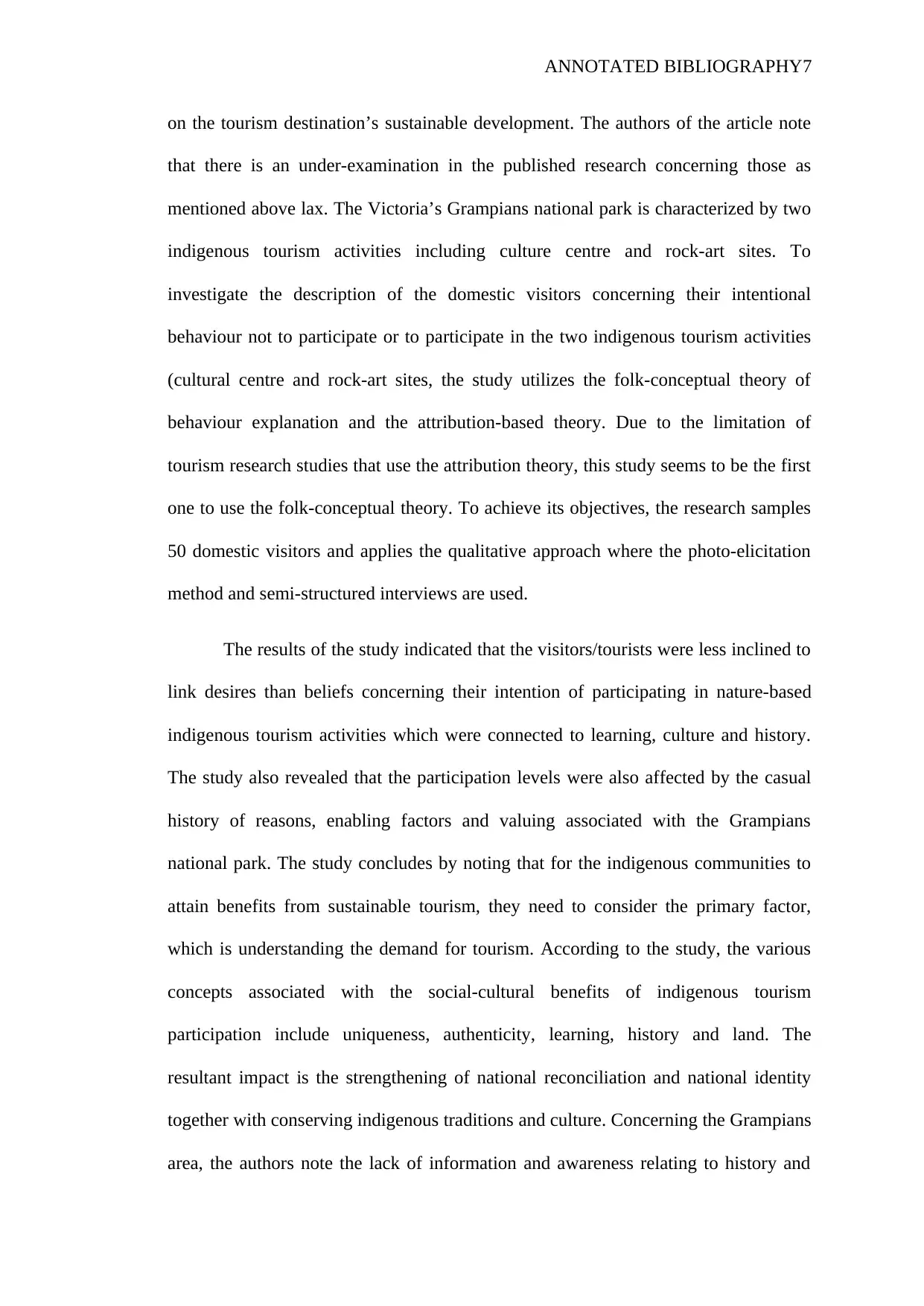
ANNOTATED BIBLIOGRAPHY7
on the tourism destination’s sustainable development. The authors of the article note
that there is an under-examination in the published research concerning those as
mentioned above lax. The Victoria’s Grampians national park is characterized by two
indigenous tourism activities including culture centre and rock-art sites. To
investigate the description of the domestic visitors concerning their intentional
behaviour not to participate or to participate in the two indigenous tourism activities
(cultural centre and rock-art sites, the study utilizes the folk-conceptual theory of
behaviour explanation and the attribution-based theory. Due to the limitation of
tourism research studies that use the attribution theory, this study seems to be the first
one to use the folk-conceptual theory. To achieve its objectives, the research samples
50 domestic visitors and applies the qualitative approach where the photo-elicitation
method and semi-structured interviews are used.
The results of the study indicated that the visitors/tourists were less inclined to
link desires than beliefs concerning their intention of participating in nature-based
indigenous tourism activities which were connected to learning, culture and history.
The study also revealed that the participation levels were also affected by the casual
history of reasons, enabling factors and valuing associated with the Grampians
national park. The study concludes by noting that for the indigenous communities to
attain benefits from sustainable tourism, they need to consider the primary factor,
which is understanding the demand for tourism. According to the study, the various
concepts associated with the social-cultural benefits of indigenous tourism
participation include uniqueness, authenticity, learning, history and land. The
resultant impact is the strengthening of national reconciliation and national identity
together with conserving indigenous traditions and culture. Concerning the Grampians
area, the authors note the lack of information and awareness relating to history and
on the tourism destination’s sustainable development. The authors of the article note
that there is an under-examination in the published research concerning those as
mentioned above lax. The Victoria’s Grampians national park is characterized by two
indigenous tourism activities including culture centre and rock-art sites. To
investigate the description of the domestic visitors concerning their intentional
behaviour not to participate or to participate in the two indigenous tourism activities
(cultural centre and rock-art sites, the study utilizes the folk-conceptual theory of
behaviour explanation and the attribution-based theory. Due to the limitation of
tourism research studies that use the attribution theory, this study seems to be the first
one to use the folk-conceptual theory. To achieve its objectives, the research samples
50 domestic visitors and applies the qualitative approach where the photo-elicitation
method and semi-structured interviews are used.
The results of the study indicated that the visitors/tourists were less inclined to
link desires than beliefs concerning their intention of participating in nature-based
indigenous tourism activities which were connected to learning, culture and history.
The study also revealed that the participation levels were also affected by the casual
history of reasons, enabling factors and valuing associated with the Grampians
national park. The study concludes by noting that for the indigenous communities to
attain benefits from sustainable tourism, they need to consider the primary factor,
which is understanding the demand for tourism. According to the study, the various
concepts associated with the social-cultural benefits of indigenous tourism
participation include uniqueness, authenticity, learning, history and land. The
resultant impact is the strengthening of national reconciliation and national identity
together with conserving indigenous traditions and culture. Concerning the Grampians
area, the authors note the lack of information and awareness relating to history and
Paraphrase This Document
Need a fresh take? Get an instant paraphrase of this document with our AI Paraphraser
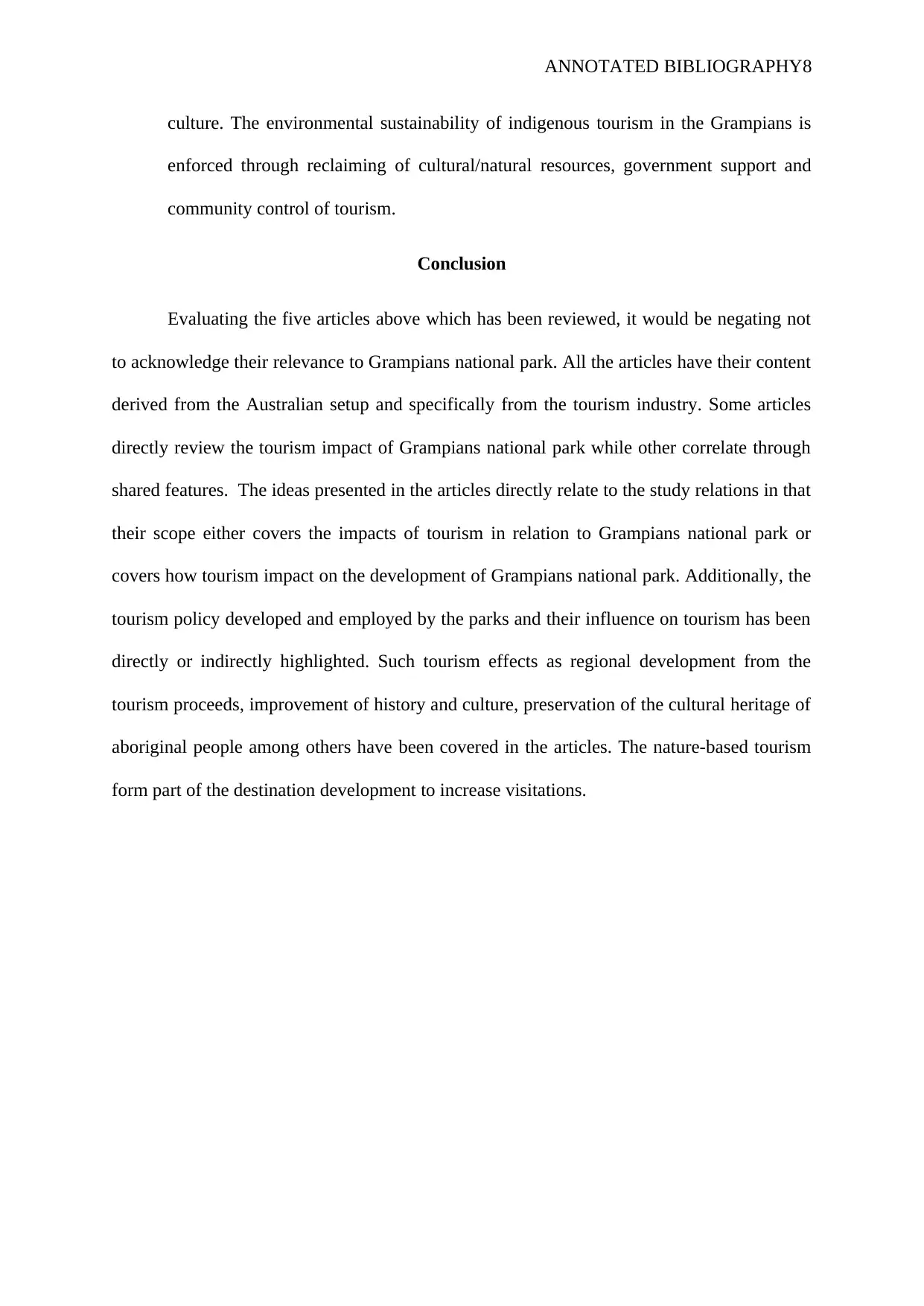
ANNOTATED BIBLIOGRAPHY8
culture. The environmental sustainability of indigenous tourism in the Grampians is
enforced through reclaiming of cultural/natural resources, government support and
community control of tourism.
Conclusion
Evaluating the five articles above which has been reviewed, it would be negating not
to acknowledge their relevance to Grampians national park. All the articles have their content
derived from the Australian setup and specifically from the tourism industry. Some articles
directly review the tourism impact of Grampians national park while other correlate through
shared features. The ideas presented in the articles directly relate to the study relations in that
their scope either covers the impacts of tourism in relation to Grampians national park or
covers how tourism impact on the development of Grampians national park. Additionally, the
tourism policy developed and employed by the parks and their influence on tourism has been
directly or indirectly highlighted. Such tourism effects as regional development from the
tourism proceeds, improvement of history and culture, preservation of the cultural heritage of
aboriginal people among others have been covered in the articles. The nature-based tourism
form part of the destination development to increase visitations.
culture. The environmental sustainability of indigenous tourism in the Grampians is
enforced through reclaiming of cultural/natural resources, government support and
community control of tourism.
Conclusion
Evaluating the five articles above which has been reviewed, it would be negating not
to acknowledge their relevance to Grampians national park. All the articles have their content
derived from the Australian setup and specifically from the tourism industry. Some articles
directly review the tourism impact of Grampians national park while other correlate through
shared features. The ideas presented in the articles directly relate to the study relations in that
their scope either covers the impacts of tourism in relation to Grampians national park or
covers how tourism impact on the development of Grampians national park. Additionally, the
tourism policy developed and employed by the parks and their influence on tourism has been
directly or indirectly highlighted. Such tourism effects as regional development from the
tourism proceeds, improvement of history and culture, preservation of the cultural heritage of
aboriginal people among others have been covered in the articles. The nature-based tourism
form part of the destination development to increase visitations.
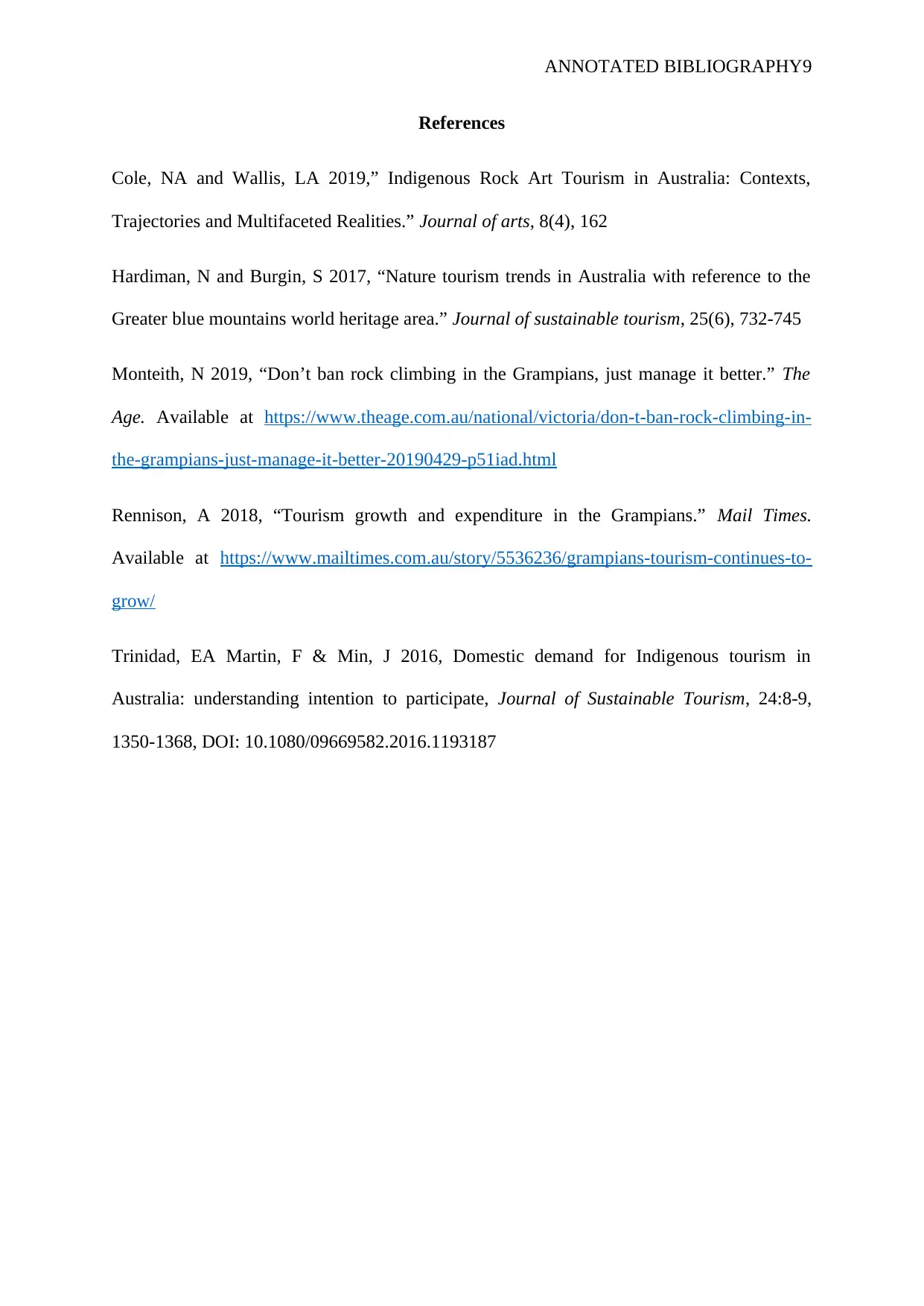
ANNOTATED BIBLIOGRAPHY9
References
Cole, NA and Wallis, LA 2019,” Indigenous Rock Art Tourism in Australia: Contexts,
Trajectories and Multifaceted Realities.” Journal of arts, 8(4), 162
Hardiman, N and Burgin, S 2017, “Nature tourism trends in Australia with reference to the
Greater blue mountains world heritage area.” Journal of sustainable tourism, 25(6), 732-745
Monteith, N 2019, “Don’t ban rock climbing in the Grampians, just manage it better.” The
Age. Available at https://www.theage.com.au/national/victoria/don-t-ban-rock-climbing-in-
the-grampians-just-manage-it-better-20190429-p51iad.html
Rennison, A 2018, “Tourism growth and expenditure in the Grampians.” Mail Times.
Available at https://www.mailtimes.com.au/story/5536236/grampians-tourism-continues-to-
grow/
Trinidad, EA Martin, F & Min, J 2016, Domestic demand for Indigenous tourism in
Australia: understanding intention to participate, Journal of Sustainable Tourism, 24:8-9,
1350-1368, DOI: 10.1080/09669582.2016.1193187
References
Cole, NA and Wallis, LA 2019,” Indigenous Rock Art Tourism in Australia: Contexts,
Trajectories and Multifaceted Realities.” Journal of arts, 8(4), 162
Hardiman, N and Burgin, S 2017, “Nature tourism trends in Australia with reference to the
Greater blue mountains world heritage area.” Journal of sustainable tourism, 25(6), 732-745
Monteith, N 2019, “Don’t ban rock climbing in the Grampians, just manage it better.” The
Age. Available at https://www.theage.com.au/national/victoria/don-t-ban-rock-climbing-in-
the-grampians-just-manage-it-better-20190429-p51iad.html
Rennison, A 2018, “Tourism growth and expenditure in the Grampians.” Mail Times.
Available at https://www.mailtimes.com.au/story/5536236/grampians-tourism-continues-to-
grow/
Trinidad, EA Martin, F & Min, J 2016, Domestic demand for Indigenous tourism in
Australia: understanding intention to participate, Journal of Sustainable Tourism, 24:8-9,
1350-1368, DOI: 10.1080/09669582.2016.1193187
⊘ This is a preview!⊘
Do you want full access?
Subscribe today to unlock all pages.

Trusted by 1+ million students worldwide
1 out of 9
Your All-in-One AI-Powered Toolkit for Academic Success.
+13062052269
info@desklib.com
Available 24*7 on WhatsApp / Email
![[object Object]](/_next/static/media/star-bottom.7253800d.svg)
Unlock your academic potential
Copyright © 2020–2025 A2Z Services. All Rights Reserved. Developed and managed by ZUCOL.